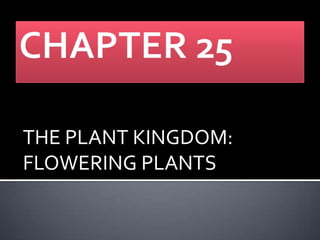Plant Kingdom-Flowering Plants
•Descargar como PPTX, PDF•
1 recomendación•921 vistas
Botany Subject Chapter 25
Denunciar
Compartir
Denunciar
Compartir

Recomendados
Más contenido relacionado
La actualidad más candente
La actualidad más candente (20)
Ranunculaceae group in Homoeopathic Materia Medica.

Ranunculaceae group in Homoeopathic Materia Medica.
Destacado
Destacado (8)
Northern areas: State of Environment and Development Plan

Northern areas: State of Environment and Development Plan
Similar a Plant Kingdom-Flowering Plants
Similar a Plant Kingdom-Flowering Plants (20)
Último
Making communications land - Are they received and understood as intended? webinar
Thursday 2 May 2024
A joint webinar created by the APM Enabling Change and APM People Interest Networks, this is the third of our three part series on Making Communications Land.
presented by
Ian Cribbes, Director, IMC&T Ltd
@cribbesheet
The link to the write up page and resources of this webinar:
https://www.apm.org.uk/news/making-communications-land-are-they-received-and-understood-as-intended-webinar/
Content description:
How do we ensure that what we have communicated was received and understood as we intended and how do we course correct if it has not.Making communications land - Are they received and understood as intended? we...

Making communications land - Are they received and understood as intended? we...Association for Project Management
Último (20)
Python Notes for mca i year students osmania university.docx

Python Notes for mca i year students osmania university.docx
General Principles of Intellectual Property: Concepts of Intellectual Proper...

General Principles of Intellectual Property: Concepts of Intellectual Proper...
Unit-V; Pricing (Pharma Marketing Management).pptx

Unit-V; Pricing (Pharma Marketing Management).pptx
Fostering Friendships - Enhancing Social Bonds in the Classroom

Fostering Friendships - Enhancing Social Bonds in the Classroom
UGC NET Paper 1 Mathematical Reasoning & Aptitude.pdf

UGC NET Paper 1 Mathematical Reasoning & Aptitude.pdf
Salient Features of India constitution especially power and functions

Salient Features of India constitution especially power and functions
This PowerPoint helps students to consider the concept of infinity.

This PowerPoint helps students to consider the concept of infinity.
Making communications land - Are they received and understood as intended? we...

Making communications land - Are they received and understood as intended? we...
Unit-IV; Professional Sales Representative (PSR).pptx

Unit-IV; Professional Sales Representative (PSR).pptx
HMCS Max Bernays Pre-Deployment Brief (May 2024).pptx

HMCS Max Bernays Pre-Deployment Brief (May 2024).pptx
Plant Kingdom-Flowering Plants
- 1. THE PLANT KINGDOM: FLOWERING PLANTS
- 2. In evolution, new structures or organs often originated by modification of previously existing structures or organs. Comparisons of the arrangement of vascular tissues in both flowers and leafy stems and of the developmental.
- 3. In the middle of Jurassic period (180 million years ago –mya-) several gymnosperm lines existed, resembling those flowering plants. Coevolution is a mutual adaptation between plants and their animal pollinators. Paleobotanists ( biologists who study fossil plants) determined that ancient gymnosperms are in the direct line of evolution leading to the flowering plants.
- 4. Gnetophytes are the gymnosperm group. TRIVIA: The oldest definitive trace of flowering plants in the fossil record in Jurassic and Lower Cretaceous rocks some 125 million to 145 million years old. The oldest fossilized flowers are about 118 million to 120 million years old
- 5. These are : Amborella, Water Lilies and Star Anise Basal Angiosperms consists of 170 species thought to be ancestral to all other flowering plants. It is also arranged spirally (as opposed to fewer parts with a whorled arrangement). And the oldest surviving group of basal angiosperms is represented by a single living species which is AmborellaTrichopoda.
- 6. Core Angiosperm are divided into three subgroups: Magnoliids, Monocots and Eudicots. Magnoliids is the group of flowering plants and classified traditionally as “dicots”. Magnoliids include several economically important plants such as black pepper, avocado,nutmeg, and bay laurel.
- 7. Flowering plants as the principal photosynthetic organisms in land, provide other organisms with a continuous supply of energy that they must have to survive. All animals require flowering plants directly or indirectly. Organisms: -deer -garter snake -toad -grasshoppers
- 8. Magnolia family (Magnoliaceae). They are easy to recognize because they have simple, alternate leaves and large, conspicuous flowers that contain numerous stamens and pistils. The fruit is conelike. And about 220 species of trees and shrub native to temperate and tropical areas of Asia and America.
- 9. Walnut Family (Juglandaceae). Walnut family are monoeciuos and bear separate male and female flowers on the same plant. The leaves are pinnately compound and arranged alternately on the stem. The male flowers occurs in catkins clusters of tiny pendulous stalk, produce pollen that is carried by the wind to a female flowers.
- 10. The female flowers are small, lack petals, and usually occur individually on small, erect stalks. And about 50 to 60 species of walnuts, hickories, and pecans. All are deciduous trees native to the temperate and subtropical areas of Asia and North and South America.
- 11. The Cactus Family (Cactaceae). There are more 200o species of perennial herbs, vines, shrubs, and small trees that are native to North and South America, also naturalized in China, India and the Mediterranean. The greatest number and variety of cacti occur in Mexico; in USA most abundant in Texas, Arizona, and New Mexico.
- 12. Cacti usually live in deserts and are succulent plants. Most cacti have spines. Cacti are of economic importance primarily as ornamentals, although some are cultivated for their fleshy, edible fruits. Some cactus species are in danger of extinction because they have been over collected for “ desert landscaping “.
